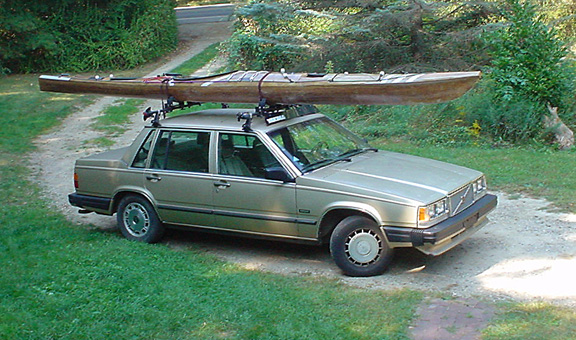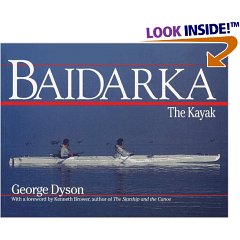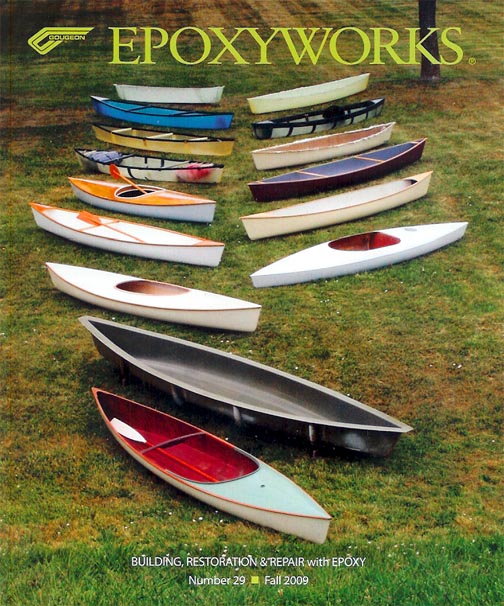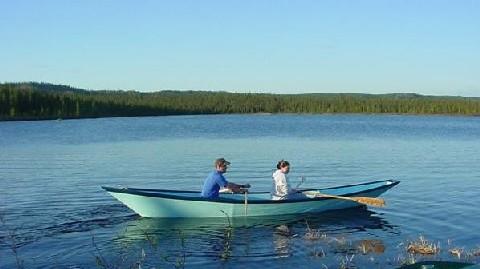Why is seakayaking so cool? I thought I’d rhapsodied about it to Martha many times before but the other day she expressed bafflement as to what I was doing with this seakayak stuff. Whew, you’d think someone’s life essence would be more apparent by now… Well, she admitted that I like all that kind of stuff but why this in particular…there aren’t any seas around here and I’m not an extreme kind of person.
OK, so here goes, here’s why seakayaking is cool and makes sense for someone like me. Both generalities and particulars forthcoming.
(By the way, I also think some seakayaks can look good on cars. We all have an image, so why not play it up, is what I say: the homemade, dialed-in style is an image I’m going for these days. My seakayak doesn’t hurt that at all as I drive to and fro the lake. Same thing for my bikes. You can have a generic bike or a bike to wow the world in its craftiness. People say image doesn’t matter. I say that what you show the world can have a good, inspiring affect on others. Like when I see a truck camper homemade out of wood, I always feel hope.)
Seakayaking is the simplest form of big water boating. You can go lots of places on all kinds of big lake (sea) water in seakayaks. And there’s, like, 2 parts but no moving parts. There’s a boat and a paddle. I mean, the parts move—boy, do they!—but they’re each one part. (It’s even more minimalist than skis, which have bindings as their only moving part.)
But what’s so cool about simple boating? Well, as any hackaround adventurer type can tell you: simpler is gooder. The more stuff to go wrong the more will go wrong. Now, bigger is fine sometimes, too. But one of the last times I ran into a bunch of diehard live-on-the-beach-in-tipi’s types of buddies we happened to be in seakayaks. It was funny—I happened to go up north to an area that I hadn’t visited in years and borrowed a seakayak to wander around for an afternoon while a friend was at work. While out wandering I ran into, on the water, an old housemate from Colorado and then while paddling down a remote island beach I ran into another old old pal sitting in the sand, wearing a chinaman’s hat like a Buddha. He was living in a tipi just off the beach (there was a girl in a bikini sunning over the rise as well). And a car battery running some speakers hanging in trees. We all had a pow-wow and one notion mentioned was that these guys had each started out in small boats, then had gotten bigger and bigger boats and sailboats but had now gradually gotten smaller and smaller. And they found that they actually used them more and more and went on more trips. All in the same wild lake waters. So small doesn’t really hold you back. Less is more.
One nice thing about small boats is that you can haul them up onto any beach, pretty much. The bigger a boat the trickier the stops and overnights are. Anchoring is where nearly all accidents occur.
But none of this is the best reason why seakayaks are so cool.
OK, in canoeing and other boating, you’re generally on top of the water. In fact, I like standing up in canoes a lot of the time, either poling or paddling with a long paddle. You get just the greatest views when standing in a canoe. I can hardly sit down anymore. But even though it’s fun you’re out of the water; it’s dry, you can get parched up there.
The coolest thing about seakayaking is the semi-immersion nature and experience of it. You’re half in and half out of the water a lot of the time, and that’s OK. What with waves and bracing yourself with the paddle against them your hands, arms, shoulders, chest, deck, half your skirted cockpit: are all covered in water a lot of the time. Even solid water. You’re working and doing things down in the water. And on hot days or just when you want to be more part of the water, that’s why seakayaking is just so darn cool.
I’m still working on my eskimo roll. My seakayak is a superlong, super-round (like a log, a friend says), superfast one, with a high back deck. It sucks for rolling, basically. But not so bad. I’m up for it because it’s such a cool character-boat. Oblong-shaped boats with low back decks are made for rolling. They’re SO sweet for it. Your body just flops that boat back out of the water.
My super-racer pal Tom does the coolest thing when out playing with his rolls. He’s cruising forward quickly then drops in on one side and goes under and strokes out from under the other side all without the boat hardly slowing down. It’s like he just pinwheels along. Or rotates like a propeller. That looks like great fun. Use ALL the water for your paddling, baby! –Even the water UNDER the boat. Oh yeah!
We do all kinds of semi-immersion and full-immersion drills to stay limber and ready for this seakayak action. You use the drill skills all the time anyway. Like with bracing. We flop to either side doing low and high braces. Or we do speed-slide low-braces. In all these braces we practice going down so low that we’re half submerged then sweep back up. It’s just so much fun on a hot day.
Basically all a roll is is a high brace started from underwater.
One major note is to never let your elbow get higher than your arm in any move. Say goodbye to your shoulder if you do. Seakayak moves are usually done with low arms and hands, or as low as possible. This is low energy and low stress. Unfortunately, those who learned flatwater race style paddling tend to work with high arms and hands: this is bad for the wide motion ranges and heavy water forces of seakayaking. Move all you like but keep your elbows low, below your hand and the paddle shaft.
Our rolling and rescue drills all involve getting comfy laying over with our torsos/bodies in the water. We flop over and grab the bow of a friend’s boat, then just lay out in the water and relax. Then you flick your hip and right the boat, letting your head come out of the water last and toward the rear of the boat. It’s a supercool floppy move. Then we practice hanging upside down under the boat, then grabbing a bow and coming up to halfway then flicking the rest of the way up. Supposedly you can learn to scull and rest with torso laying in the water. Sounds cool, but I hear a low-deck helps make that possible (keep elbows low here!).
We also practice various wet-escape rescues. One of these is where you fall over, peel off your skirt and roll out of the boat. Come up, get yourself sorted out. Then go back under and reverse-somersault back up into the boat, put the skirt back on, get your paddle and roll back up, then pump your cockpit dry (my boat has bulkheads in front and back of cockpit so that area doesn’t hold much water).
I also like the sit-on-top surfskis. They don’t sink. If you fall off, you just squirm back on. I tried a really long skinny one once in big storm waves: oh yeah! I could just blast along and the bow-lifter would send the bow launching high in the sky while the wave absorbed me and the boat as we blastest thru at high speed.
I don’t really like whitewater action. Dealing with flow and obstacles can be scary. There’s always a risk of entrapment, even in shallow weak flow. Just get a boat pinned upstream of an object, have it tip, get stuck in the boat and Hey! you’re drowning. I had it happen in like 6″ of water once. Embarrassing but probably an effective way to get killed. Still, I can see having bouncy surfing fun around moderate boulder waves away from logjams. And when one’s manuevering skills are honed just paddling down thru rapids up to Class 3 isn’t too tough. Just know what’s ahead of you. And how many people really bother to check out obstacles on minor rivers? In wild areas they can be even sneakier perhaps than known scary water. On boony rivers around here the blowdowns don’t get cleared out very often. So you could be in moderately strong current, round a corner and find yourself trapped. Careful! –I find that having a rudder even on canoes makes manuevers such a breeze, but I’ve only ever had a rudder for a short time, so don’t know them all that well (I assume the moving-parts factor can result in as much trouble from rudders as they cure…or more, if Murphy holds true).
Not that seakayaking is safe. Tom and Karl relate many scary tales, including those involving death. Most involve expert paddlers. Murphy is in full play among seakayaks. Karl gets fed up with the scene. Seakayaking gets to be too popular for him, it seems: group outings tend to grow to include strangers and get a party atmosphere. It’s good to paddle with a couple others but darn you better know them well and better all be on the same page skillwise and always err on the side of caution. One big thing that sticks out to me in their stories is the heavy leverage wacking power of a long kayak on the water when one boat goes near another to help it out. It’s wavey in trouble times and those waves throw heavy boats at other boats and the people in them. Also, waves come at every angle: these variations easily cause surprise stresses on shoulders: a very weak link. You dislocate a shoulder out in the water a ways and you’re in a world of trouble even with lots of skills.
Anyway, I find that I start thinking “seakayak” every year in late August. I don’t know why. Maybe less bugs finally, maybe bluer skies and cooler air with still-warm water. The water is superfresh seeming then. I’ve usually been biking a lot. It just seems time to COOL OFF! And a seakayak seems a great way to do it.
Martha says, but we don’t have any big lakes around here. Well, the seakayak is a way to have fun even in our local max-boring round, shallow totally developed lake. There are far fewer motorboats out making noise. Of course, I’d also like to get my sail rig going on my big canoe. Sailing in the clear, breezy autumn with the geese on our quiet, if totally boring lake, is a great way to go. It’s so boring that the 3 bars near it are all a block off of it and none have patios, but still with a canoe or kayak one can go boating then whet your whistle and still feel a LITTLE bit of fresh-air boat culture.
But I also start dreaming of the Straits and of paddling the Great Lakes. We sometimes go tenting/trailering in late summer on a Great Lake shore. A seakayak is nice then. I’ve taken canoes before but they seem to keep me too far away from that crystal clear water. I want to someday be good enough to paddle the 3 miles of lovely but deadly Straits water from St. Ignace to Mackinaw Island, to save the $30 roundtrip ferry fee (now how to get a folding bike into the kayak…).
Seakayaks are also so pretty. There are boats then there are boats. Some are REAL pretty. I like the ones with low decks and double upswept ends. But I also like long ones. I don’t really need speed but a long boat lets you go twice as fast for any effort. My wimpy paddling lets me visit far places in short order in a long boat. In a short boat you can go down the beach and back in an hour or two. In my cool boat I can go a mile beyond the horizon and back in the same time. My boat is a 19-foot long woodstrip ugly beast, patterned after one of the winningest boats, the Seda Glider. It’s fully equipped for expeditions. It has a rugged style all its own, built by my pal Karl. Towns are far apart on Michigan beaches. My boat gets me there for a beer then back in short order. Carrying 100 pounds of purty beach rocks, if I like.
I have a yet-further history with seakayaks that I haven’t told you about yet. I used to be young and bold and in good shape and paddled every day. In those days, when I was 21 and fresh out of journalism school, I got hired to be the assistant editor of CANOE mag, in Camden, Maine. Those were fun days. I think I made myself be hired—I drove out and camped nearby and pestered the bosses and told em “Let’s just go paddle and maybe talk about this hiring stuff.” So we all went out seakayaking one afternoon and I got hired. Lord knows why. It was about the last time they paddled, when I knew them. I think I was just too young—probably also too gungho and not deferential enough, not New Englandy enough. I wanted to cover more paddlesport and I used duelish and combative terms in stories: “hammering” and “attacking” weren’t allowed. Paddling was cosmic art, to them—I agreed heartily but I expanded on that to include fiestiness. I also wasn’t into E.S.T., but that’s another story. Anyway, I’d paddle all the mag’s stable of boats most every day, taking them out, putting them back in the shop. Eventually, since no one else ever used them, they all ended up in my backyard. Well, about 8 of them anyway. 4 seakayaks and 4 styley canoes. I had no use for the whitewater boats. This was in 1983-84. And it was right when seakayaks started coming on strong. There were only a couple “cool” models available at that point, the coolest being the boss’s Nordkapp, but I’d mostly sink it so I didn’t use that one.
I’d go paddling everyday on the inland millpond-river and on the ocean bay. I’d see seals every day and otters, too, even though locals said there weren’t any. I hardly ever saw anyone on the water but me. I saw what they didn’t. I’d see the otters right by the dam in town even. I also once saw an aqua-colored amphi-car being driven across the local yet wild and lonely chain’o’lakes (wide parts in the river), with this elderly couple in it, him driving in fedora, her in a hairnet. That was something.
I lived with a sea captain then, rented a room in his house. He ran the Bowdoin, a huge tall ship. It was a one-man show. I helped him work on it once: we moved a 30-foot long 12″x12″ beam into it, just him and me. I had no idea how we’d do it. He did. No wasted effort or time. His partner was the publisher of the Boston Globe. He’d come up sometimes and help out. Seemed like a regular chubby little guy in overalls. The sea captain lived out of a duffle. I often had the house to myself. It was a house that seemed unchanged since the 20’s. I had one dresser, a typewriter and a ton of books. My girlfriend moved out with me and rented a room in a lady’s mansion. The mansion was seriously said to be haunted by some captain’s widow. They didn’t make a big deal of it, like it was common.
Now, I recently started re-reading “The Starship and the Canoe,” about the Dyson father and son and their respective nuclear rocket and seakayak. That book was big back then. As I’m reading along I remembered that I’ve seen icebergs and paddled around them. I’d totally forgotten. They were out there near Camden. Big and glowing blue.
I didn’t know jack about rolling or rescue back then. I just knew that I’d had jillions of crazy things happen in boats and I could almost always simply NOT fall in. I might have adopted my “refuse to crash” mantra about then. But I only ever paddled by myself. Sometimes way out to sea. Sometimes in dark storms and big waves and lightning. Yikes. Well, I don’t do that anymore.
And if you want to read a superb and marvelous story of cosmic exploration, both watery and celestial, in the modern age, you really do have to read “Starship”…just click on the cover to learn more and order it via my Amazon “store”…
But here’s my punchline: We received a manuscript at CANOE magazine that just blew my mind. It was from George Dyson for the book that would launch the hardcore seakayak movement a few years later, “Baidarka.” That book truly launched the seakayak revolution of the 80’s and 90’s. Oops, the 90’s. I wanted to publish it, but was told that we didn’t do books. The manuscript itself was the shocker, though: it was fabricated just like George’s boats! His boats are made of aluminum with kevlar lashing. The manuscript was bound in aluminum and stitched with kevlar! Pages, original watercolor paintings and lovely photos were also sewn in with regular thread. It was a work of art itself, a collage of genius. Its box included a signed letter from Jackie Onasis from Doubleday wishing him luck and further warm sentiments of awe but helplessness in the face of such a project. Boy, they missed a good one there. We sent the box back to George.
The next year, after leaving CANOE, when I started selling tons of the engineering book I produced with my dad, I wrote George again, asking if he’d found a publisher. He had: Mountaineers. A year passed and I wrote again: they were doing nothing with it. I asked to publish it myself. He said Cool, but after he saw what another big outfit might do. The Alaska Magazine people then bought it. And sat on it again for over a year, doing nothing. I asked yet again. George said OK, let’s do it—but first we have to tell these guys their time is up. He did so, and lo and behold, they didn’t want to lose it after all and finally got off the stick and published the book. They did a great job. I like to think I helped make it happen. So that encounter with that big metal manuscript had a lasting affect on me, even though I haven’t lived near big water in years. Still…now that we have kids we’ve been visiting the Great Lakes beaches more often and the old big water love has come back…and the seakayak has reared up as a simple way to easily enjoy such water. I’m readier than ever now!
And Martha wonders why I like seakayaks.
If you want to check out “Baidarka,” it’s a bit pricey right now, being out of print for some reason with only rare copies coming up for sale. It’s been thru 6 other printings. It’ll probably come out again, but if you can’t wait…





